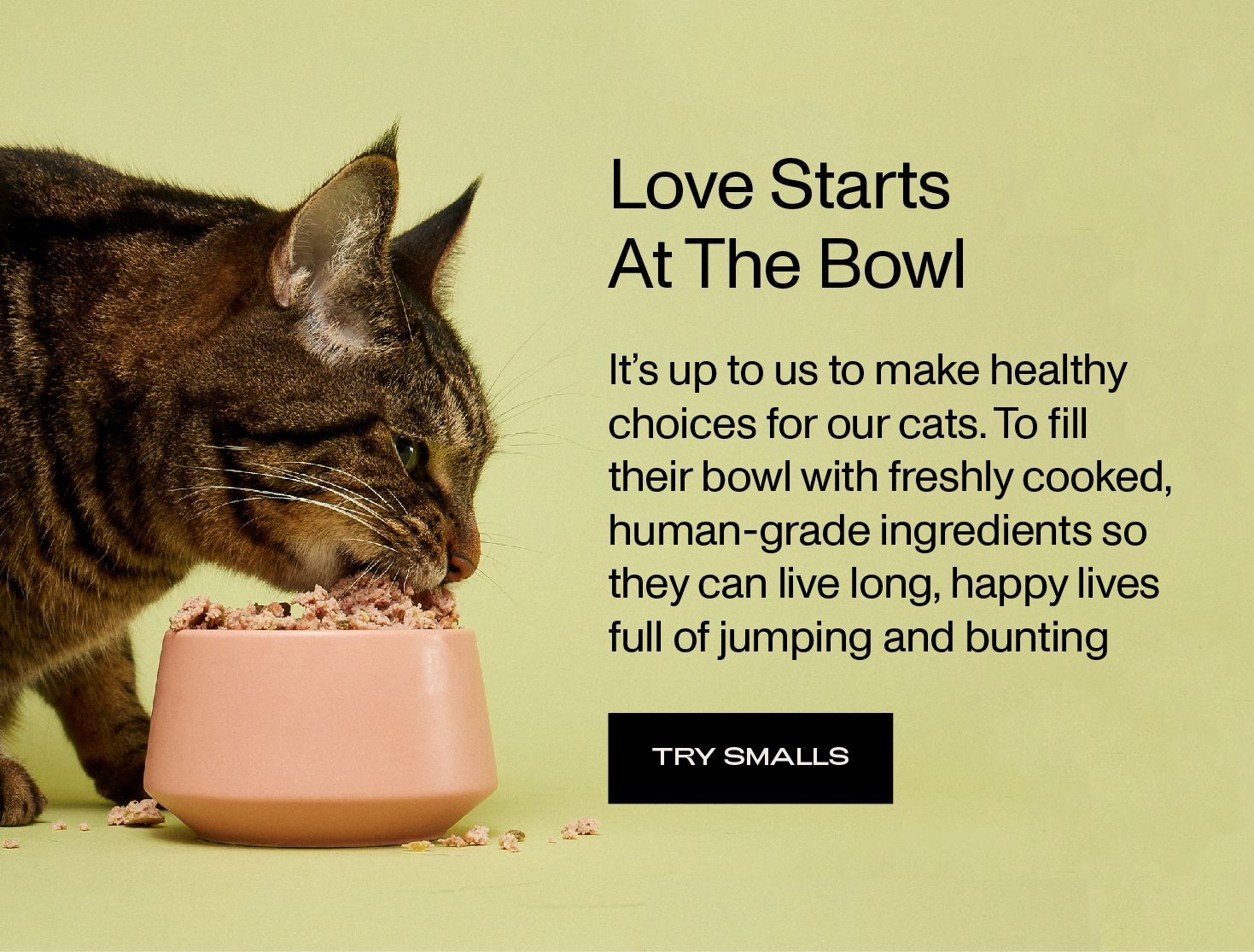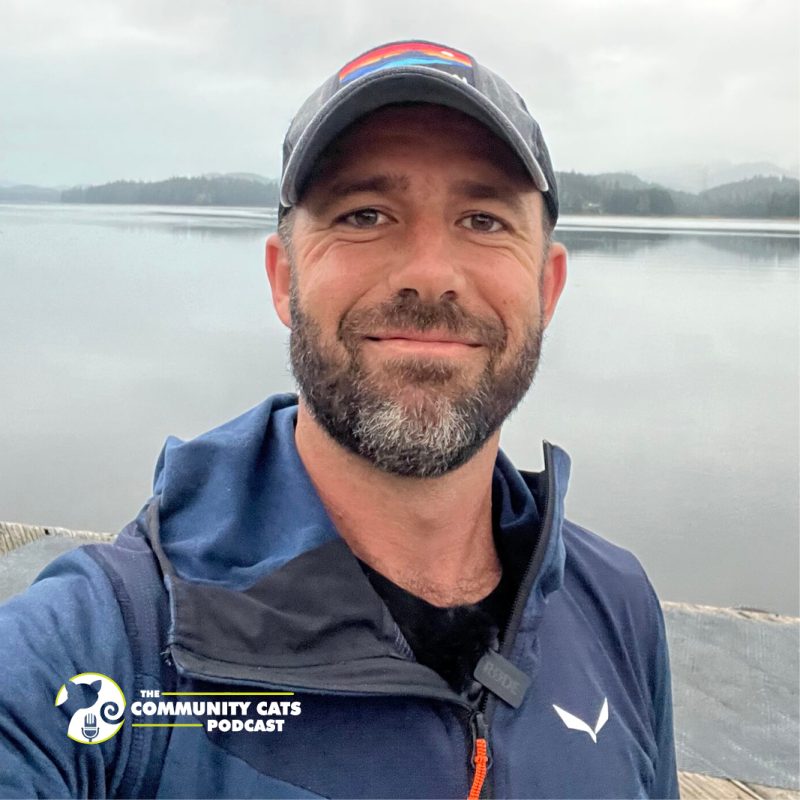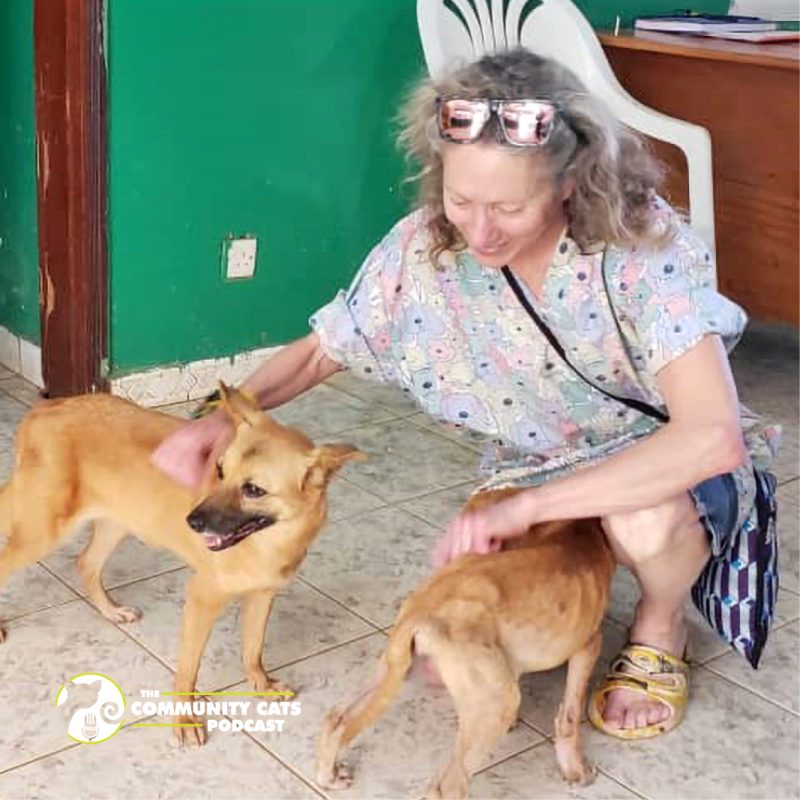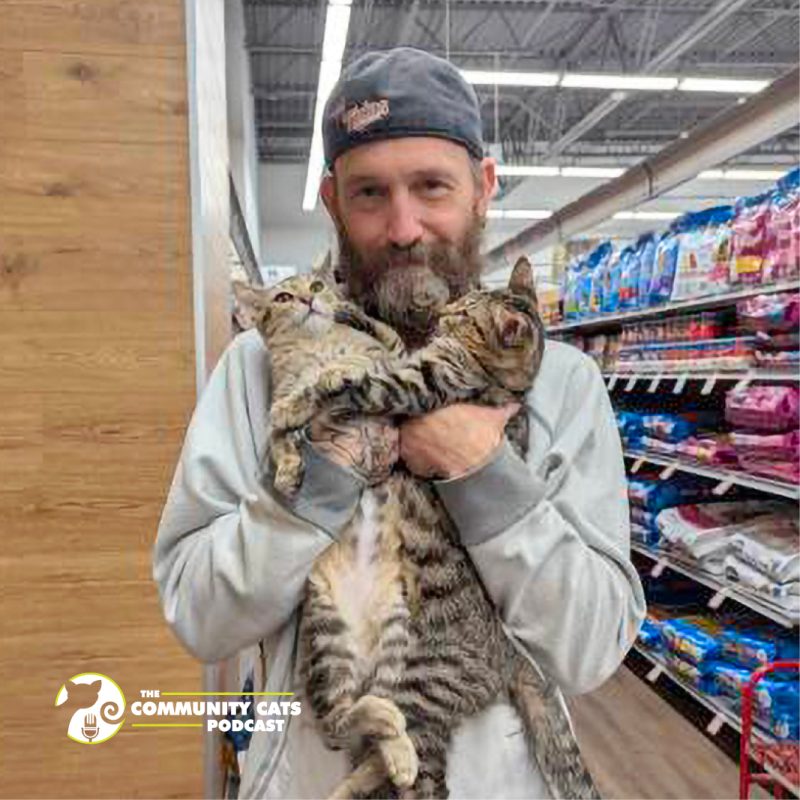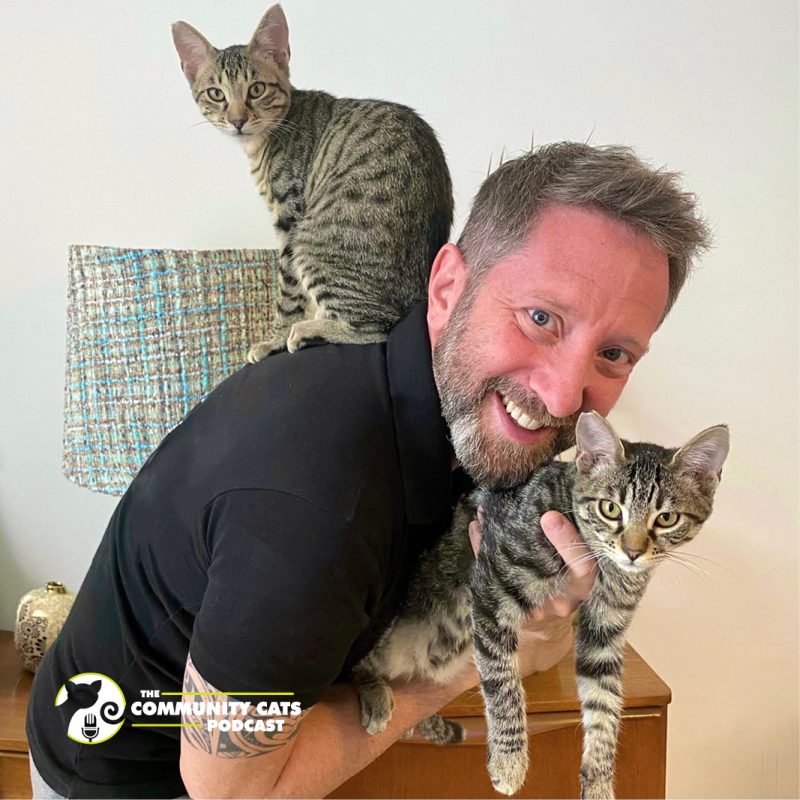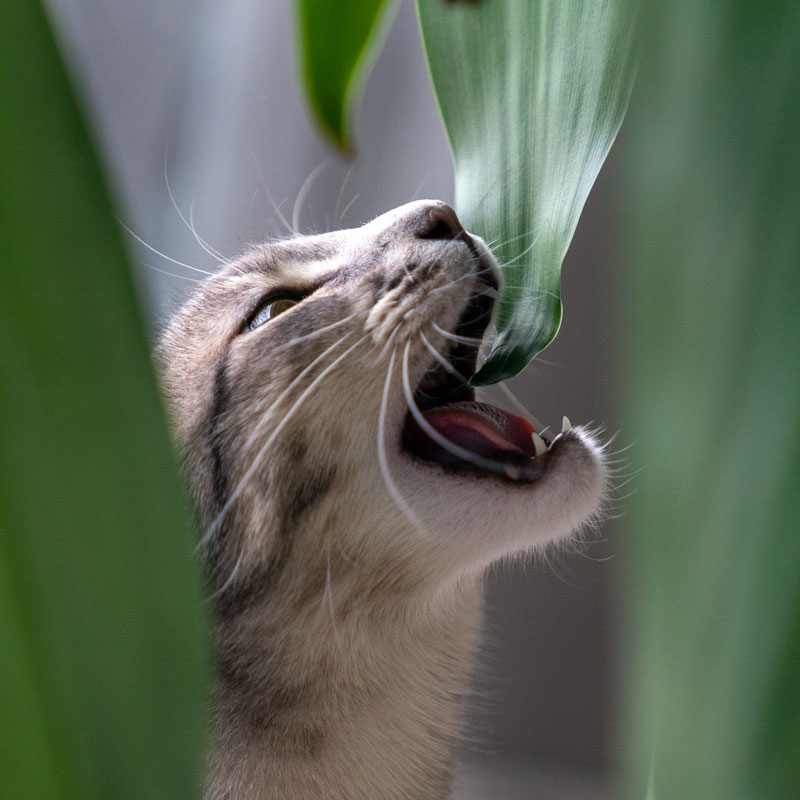
Common Kitty Behaviors and Meanings
May 20, 2021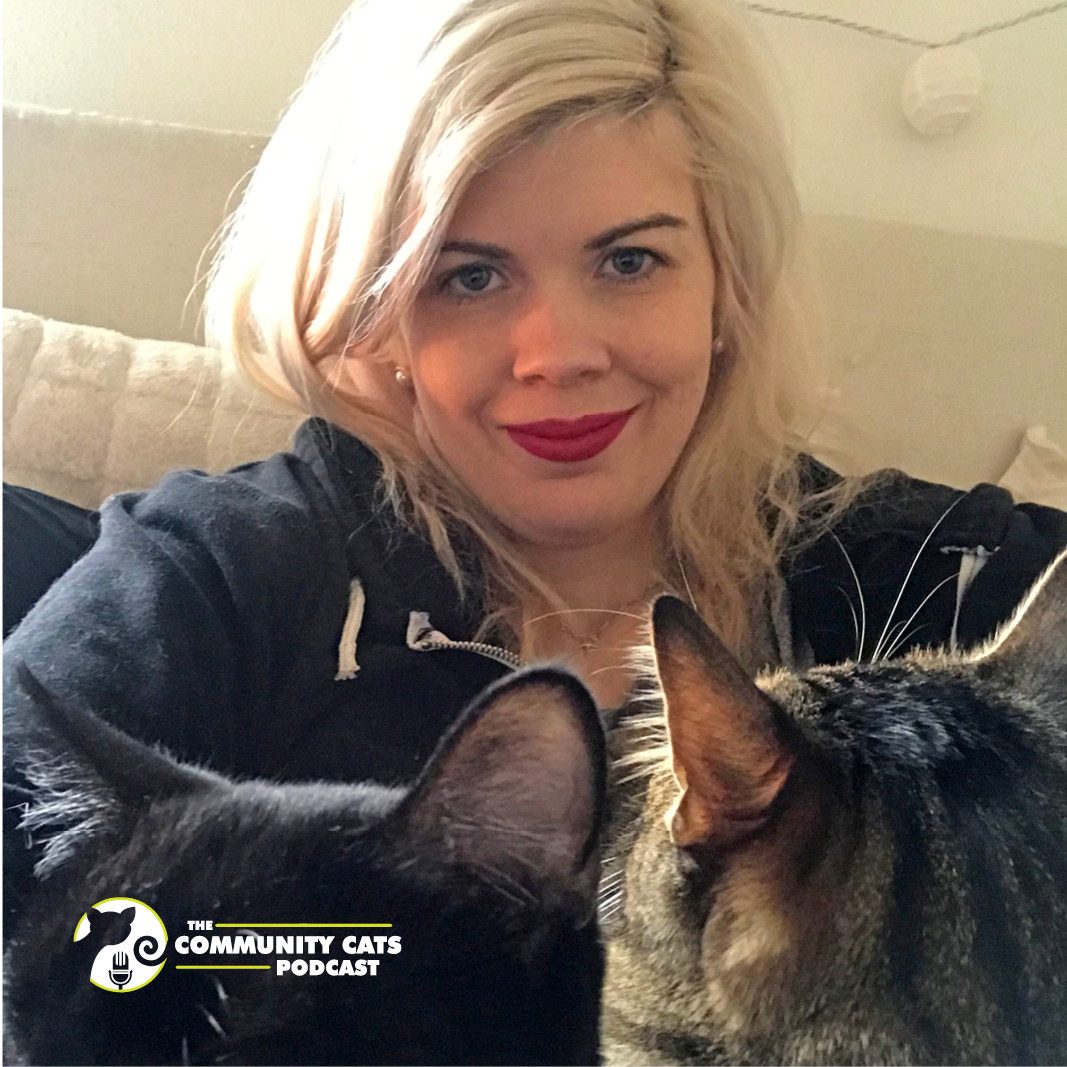
Daralyn Kelleher, YouTuber and Amateur Woodworker
June 1, 2021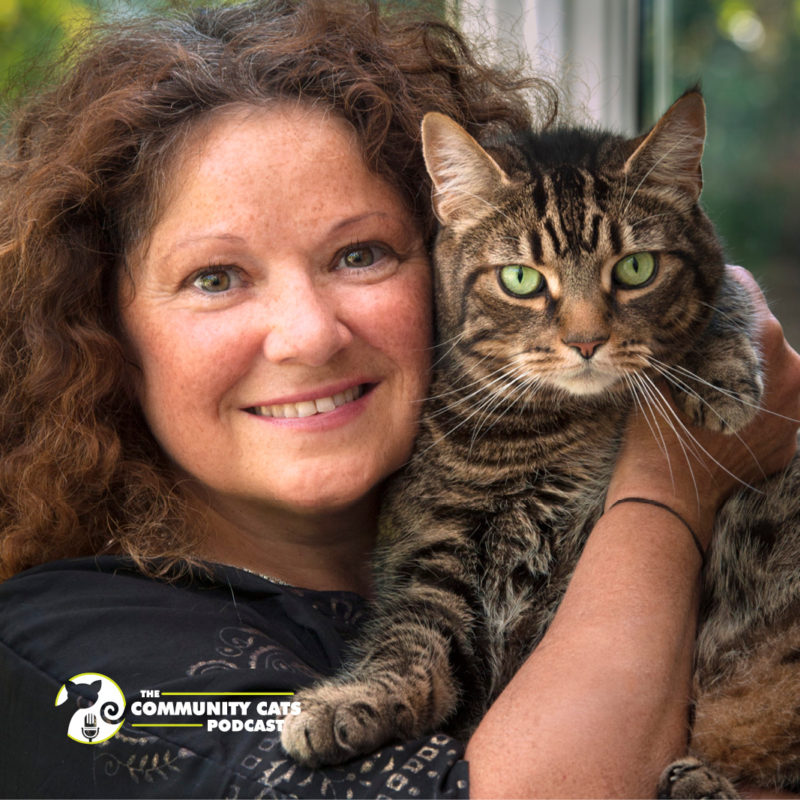
“It made me step back and really reflect on my life, and during that time I decided I wanted to have a complete change with my career path and my next love was cats so I decided to start working with cats.”
Listen to Episode #405 Now
This episode is sponsored in part by Smalls Fresh Cat Food and Doobert.com.
Anita Kelsey is London’s only accredited cat behaviourist (BA Hons, MCFBA, CIDBT) after studying feline psychology and behaviour with renowned cat expert and biologist Roger Tabor and achieving a first class honours degree at Middlesex University based on her work practice. Anita is also qualified as a master cat groomer has a long list of regular mobile cat grooming clients in and around London.
Anita is the author of two books, Claws: Confessions of a Cat Groomer and her newest book Let’s Talk About Cats, which we reviewed in our last book review blog. Stacy and Anita talk about some of Anita’s favorite interviews with cat professionals in Let’s Talk About Cats and the varying perceptions about cats around the world.
You can find out more about Anita and get the books on her website. You can also find her on Facebook, Instagram, and Twitter.
Read Episode #405
Kristen Petrie [00:00:02]
You've tuned in to the Community Cats Podcast. Ready? Let's go.
Stacy LeBaron [00:00:13]
Welcome to the Community Cats Podcast. I'm your host, Stacy LeBaron. I've been involved in helping homeless cats for over 20 years with the Merrimack River Feline Rescue Society. The goal of this podcast is to expose you to amazing people who are improving the lives of cats. I hope these interviews will help you learn how you can turn your passion for cats into action. And today we're speaking with Anita Kelsey. Anita holds a first-class honors degree in feline behavior and psychology, work-based based BA, and runs a vet referral service, dedicated strictly to the diagnosis and treatment of behavior problems in cats. She's also a qualified cat groomer and specializes in grooming aggressive or phobic cats. Anita writes for Your Cat Magazine and is on their expert panel answering reader's questions on cat grooming. She also advises on feline behavior for the Canine and Feline Behavior Magazine, as well as being a full member. Anita, a strong advocate of a vegan lifestyle is based in London, but also consults all over the UK, as well as international requests. She lives with her husband, a music producer, and two Norwegian Forest cats, Kiki, and Zaza. Her first book, Claws Confessions of a Professional Cat Groomer was published by John Blake in 2017. And her second book, Let's Talk About Cats, just released on Amazon in the United States and the United Kingdom. Anita, I'd like to welcome you to the show.
Anita Kelsey [00:01:39]
Thank you so much for having me.
Stacy [00:01:41]
Yeah. So before we dive into all of your experiences as a professional cat groomer and everything else. First off, you've got to share with us, how did you become passionate about cats?
Anita [00:01:52]
Well, you know what? There's no specific timeline, I think I was just born loving them. I've just been obsessed with them ever since I was younger and I think even my mom always tells a story that when she was taking me to school then, nursery school, I would insist on going down a particular road, which was kind of out of the way because I knew there were lots of cats that would be sitting on the wall. And so we'd always be late to school because she'd have to go down this road with cats. So, I was just born absolutely loving cats.
Stacy [00:02:24]
You just caught the bug, that's for sure. And yeah, so those were actually outdoor kitties. So, one of your first experiences with was with outdoor cats, but yet you decided to get involved in being a feline groomer. Did you feel like you had a skill or a gift in handling cats? I mean, it's not really somebody who you know, in nursery school says, Mommy, I want to groom felines, this is my passion. So, you know, how did you get from the cats on the wall to grooming?
Anita [00:02:53]
In a way, I kind of didn't. It took about 30 to 40 years because I was a professional singer/songwriter for 40 years. So when I was younger, it was always two areas I wanted to work in. I either wanted to be a vet or I wanted to be a singer and I decided to become a singer. So that was about 30 to 40 years. And basically, I had one of these life experiences where I had a friend who basically committed suicide, which set me on a different path in life. It kind of made me step back and really reflect on my life and during that time I just decided I wanted to have a complete change in my career pattern and my next love was cats. And so, I just decided to start working with cats. So, yeah, I mean, that's the long and short of it. So, I set up a cat sitting business and that was hugely successful. And then, while I'm sitting the cats, I noticed a lot of the long-haired breeds had really bad coats, very bad matting. So I just decided to start research on how to groom cats properly. And then that led me also into feline behavior, as well. So it was a complete change around in my work and what I was used to my whole life.
Stacy [00:04:00]
So, being in London, I assume cat sitting is a pretty popular business, is it active? A lot of folks really, you know, want professional cat sitters versus maybe the kid down the street?
Anita [00:04:12]
Yeah. I mean, I'm not too sure what it's like in the US, but in the UK, it's very popular to have cat sitters and it's very popular to have live-in sitters, as well. So you look after the house and the cats. It's very big over here. But actually, I learned the trade by getting the book. An American lady wrote a book on cat-sitting and cat-sitting for profit. So it was that book that I've learned how to set up, a cat sitting business in Notting Hill and that just kind of took off organically. So everything I've done working with cats has been an organic process, which has been really lovely for me.
Stacy [00:04:44]
But you did gravitate towards feline behavior and also towards grooming. And you said it's sort of just in the daily process and the thought of grooming a long-haired cat with mats on their side is probably not a highlight in my world where it seems like you took the challenge.
Anita [00:04:59]
Yeah, I mean, I guess I had to learn how to do it because I've got two new Norwegian Forest cats myself. So there was an interest, but I think because even before when I was in the music business, I was reading books on feline behavior. And I think what really set it off was just seeing the state of people's cats I was sitting initially. That's what got me started in, ok, I really need to help these people, but I need to understand how to do this professionally. And then obviously, I looked at a gap in the market in my area and there was, I don't think there was hardly anyone, even now. There's hardly anyone that does mobile feline grooming in people's homes. It's all in dog grooming parlors. So that's kind of how I got started, just seeing the states of people's cats I sat.
Stacy [00:05:35]
Are you only doing grooming at this point in time and like behavior consulting? Or, are you still using the cat-sitting business?
Anita [00:05:43]
No, no, so the cat sitting business, I gave up about 10 years ago. And well, actually, I handed it over to my husband. He kind of took the reins for a little bit but now he's kind of moving out of that area because he loved cats as well. And because it was such a successful business in Notting Hill, he just decided to run this baby for me. But yeah, I mean, I'm way too busy with doing grooming and behavior to be sitting people's cats, but it was a really lovely stepping stone and just a lovely introduction to working with cats on a daily basis.
Stacy [00:06:10]
And you felt the need to write a couple of books. Tell me about your desire to craft the two books that you have and especially your most current book, Let’s Talk about Cats.
Anita [00:06:20]
Yeah. So the first book Claws, I basically wrote that because, after every grooming session, I have to write a report up with how the cats been on the session. And then I can look back and just refresh my memory if there's any kind of mishaps or the cat's personality, and there were so many funny things happening on the grooms I just decided this would be hilarious if I put all my notes into a book. So I found an editor, at the time, he was the editor of a really big newspaper over here called The Sun. I'm not sure if you've heard of the Sun newspaper and he just thought it was an excellent idea. And so, I handed all the stories to him and he edited the stories. So that's how Claws came about. And then I really thought it would be great to kind of follow up on Claws, but I didn't want to do a Claws 2, and I also didn't want to do a how-to book on cat behavior because I know that there's some brilliant books out there. So I know that for me, I just wanted to do something different. So, I decided to just focus the book on interviews with cat professionals, which hasn't been done before. And yeah, I just thought that it was just different from anything that's out there at the moment.
Stacy [00:07:25]
In that book, what was your most interesting interview? Which I know might be hard for you to select, or a little snippet of one of the interviews, or one of the folks that you interviewed.
Anita [00:07:34]
Funnily enough, there's lots of US people in the book. I don't know if you noticed, but I interviewed Jackson Galaxy and he came across as being so warm and just lovely to speak to. And we had a lot in common when I spoke to him because obviously, we both work with behavior in people's homes. There was Jennifer Conrad, who I watched the film The Poor Project, so I was really interested in that film and how it came about. So Jennifer was amazing, talking about them, the Poor Project campaign. Cheryl Woods because she's a cat groomer in the US and she runs a website that deals with grooming cats holistically. So I'm really interested in grooming cats with being holistic in mind and being very gentle with them. So I interview her, but I think one of those really, really special to me is a guy I interviewed, he’s called the Catman of Aleppo. He's known all around the world now and his name is Mohammad Alaa Aljaleel, and he basically stayed behind during the war in Syria to look after all the cats that when people fled, and all his neighbors fled, they left all their cats behind. So his story was amazing. So I was very lucky to get an interview with him.
Stacy [00:08:41]
Yeah, I follow him on social media.
Anita [00:08:43]
He’s incredible, I mean, I had to get an interpreter for that, and then it was very difficult. It took about a month to interview him because obviously, he's living within a war zone. And also our time differences are different, plus, the interpreter once she'd kind of tracked him down and set up a time, there were times that you had to cancel because it was too dangerous to talk to her. And then she had to basically interpret everything that he was saying. So she was really a godsend to me and it took about a month to get his interview. And also going backward and forwards with clarifications that I had as well.
Stacy [00:09:17]
That's quite impressive, what a lineup. That's amazing.
Anita [00:09:21]
I know.
Stacy [00:09:22]
You must have felt lucky to get this group together.
Anita [00:09:26]
You know, there was some people that I really couldn't have because I interviewed them Temple Grandin and it was an amazing interview and she talks about cats and autism and how she feels that cats look at life like an autistic person would look at life, but unfortunately, I couldn't have everyone's interview in the book. So, I had to let Temple go, but it was really amazing to have all these people share their expertise and shine a light on how they work with cats as well, which is what I wanted. I didn't want it to just be about me.
--Start mid-roll advertising--
Stacy [00:09:59]
Give your feline friend protein-packed meals. They'll crave with Smalls. Smalls is fresh human-grade food for cats delivered, right to your doorstep. So you too can embrace your inner house cat. All cats are obligate carnivores. They need fresh protein-packed meals. Conventional cat food is made with profits and mind using low-quality, cheap meat byproducts, grains, and starches coated and artificial flavors. Smalls, on the other paw, is made with cats in mind. Smalls develops complete and balanced recipes for all life stages with leading cat nutritionists, starting with human-grade ingredients like you or I would find at the market. Smalls recipes are gently cooked to lock in protein, vitamins, minerals, and moisture. No room for fillers. No need for flavoring. Better quality ingredients mean a better healthier life for your cat. Since switching to Smalls, cats have experienced improved digestion and a less smelly litter box, softer and shinier coats, plus better breath. Try Smalls today for your cats in your household. Hooch loved it. Use offer code Community Cats, at checkout for a total of thirty percent off your first order at Smalls.com.
NKE; 4.17.2022
Stacy [00:11:08]
Are you ready to be part of the solution for feral and stray cats in your neighborhood? If so, then make sure to sign up for our next Neighborhood Cats TNR certification Workshop. A new workshop is held online each month, generally on the first Saturday of the month, but please check our website for exact dates. For just $10, expert instructors will teach you best practices for Trap, Neuter, and Return. TNR. Learn what TNR is and why it works. We’ll cover getting along with neighbors, preparations for trapping, trapping itself, including entire colonies at once. Feeding, providing winter shelter, and more. Take advantage of the interactive format, extensive handouts, and video footage of actual projects. Attendees will receive a certificate of attendance and gain access to an ongoing Facebook group for networking with other TNR activists. The two-and-a-half-hour workshop is led by Susan Richmond, the executive director of Neighborhood Cats, and Bryan Kortis Neighborhood Cats National Programs Director. To find out the date of the next workshop and sign up, just visit Community Cats Podcast.com.
Stacy [00:12:19]
As we emerge from the global pandemic of COVID, fostering is emerging as the new normal in the animal welfare industry, but shelter management software doesn’t provide the tools or the workflows for communicating with fosters at scale. So many organizations struggle to maintain, hundreds of animals and foster homes. If only there was a system that was custom built specifically to solve this problem. Introducing, FosterSpace. powered by our friends at Doobert. FosterSpace was custom built to allow you to manage hundreds of foster relationships and to communicate with them via text email, and even Facebook Messenger. Your fosters have a portal where they can upload videos and photos and updates on their animals. And organizations can schedule, fosters for meet-and-greets, adoption days, or anything else they need. There's so much more to check out. Sign up for free at www.Doobert.com and go to the FosterSpace tab to get started.
--End mid-roll advertising--
Stacy [00:13:05]
So Anita, you know, one thing I'm interested in with the fact that you have so many clients that are around the world and you've interviewed folks that are around the world. I mean, do you think that folks perceive cats in the same way from country to country or are there different opinions about cats?
Anita [00:13:18]
I think the main thing I've come across is different opinions between the US and the UK in terms of letting your cat out. So I know when I spoke to Jackson, I think in the US you're very much advocates for keeping your cat in. And I can understand that because you've got big predators over in a lot of parts of America like coyotes and stuff. But in the UK, the culture is more that we let our cats out, and also in our rescue centers is highly unlikely that you will get a cat, just a normal cat with no health issues. Is highly unlikely, that they will give you a cat if you don't have outside access, so they're the two differences. Really, I found sometimes on my behavior cases, when I'm dealing with somebody from the US, they will be kind of fighting me, even letting their cats out in the garden with, with cat-proof area, they don't like the idea. So that's kind of the main things that I found.
Stacy [00:14:10]
So you're saying that when someone wants to adopt a healthy cat from one of the organizations in the United Kingdom, that they want you, or encourage you to have outdoor access for that cat?
Anita [00:14:22]
Correct. So, normally they would look at your home. And if you haven't got normal access to let the cat out, it's highly unlikely that you'll be able to take the cat. Unless the cat has got FIV or is disabled where it cannot go out. They tend to like a cat to have access to going outside. I know it's a big, big difference because I know when I spoke to Jackson, he was really shocked by that, but that's just cultural differences, really.
Stacy [00:14:46]
Oh, and I mean, I understand it tremendously. I think that we also have quite a strong lobbying arm of the organizations that support birders in the United States. And so they feel that cats are reducing the bird population substantially across the United States, which, that battle doesn't seem to be happening in the UK. I actually have spent a fair amount of time in Switzerland and I love in Switzerland, where there are so many of the cat ladders that go up to the second-floor windows.
Anita [00:15:17]
Sure yeah, they look amazing. I've seen lots of photographs of those.
Stacy [00:15:30]
Yeah, so it's very practical and makes a lot of sense. So, I understand. I mean, we have Trap, Neuter, and Return in the United States. We have barn programs. So I don't necessarily understand why we have to be like all outside or all inside. that there are definitely environments where it's good for cats to be indoor/outdoor.
Anita [00:15:50]
Yeah, I agree with you. I mean, I don't kind of go into my behavior conversations and say to people that every cat has to be let out because there’s some cats that can't because it's just too dangerous because they live on too much of a busy high road or there's such a high density of cats and if the cat is territorially aggressive then it's not good for either that cat or the outside cats if it goes out. So, really, my advice is definitely on per case, it changes, depending on the circumstances and there's some cats that are just going mental, just being kept in. So I'll give advice depending on the cat personality and the circumstances.
Stacy [00:16:26]
In the UK, are there groups that do practice Trap, Neuter, Return? Or that's what we call it in the United States. Yes, yeah, we have to Trap Neuter, Return too. I'm not sure we have like big cat colonies over here, but then perhaps, I don't know because I live in the city. I know that there are. I think that there are much smaller cat colonies or maybe just individual cats that would live on the street. So they definitely do Trap, Neuter, and Release and I think we have like caregivers that will see if you can see that a cat is a street cat there will be people that will be leaving food out and there's somewhere warm like a warm box for the cat to rest in and there have been occasions where I've contacted rescue centers when a cat really doesn't look in a good way, but you can see that it's a street cat. It's got that kind of haggard street look. That look of living on the streets and I think you probably know what I'm talking about. And there are times I've contacted rescue and they've come out with one of the trap boxes, but it's kind of quite difficult because if you've got cats that naturally go out over here, it's difficult to make sure your, you’re trapping the right one.
Stacy [00:17:31]
Right? And that we ran into that too. You don't want to trap an owned cat. So, yeah, that's that's a big challenge. But, yeah conversation because there are still plenty of areas where folks will have their cats indoor/outdoor, especially in situations where the cats are not already spayed and neutered. So, I mean, who wants to live with the, you know, unneutered male cat as an indoor-only cat. So, there's a lot of times where cats are allowed outside, but yet still owned and loved but, yet meant to be, you know, an outdoor kitty primarily or even indoor-outdoor, you know, in at night and out during the day.
Anita [00:18:09]
We don't really have that so much because the majority of our cats are neutered or spayed. So I think that's a really big thing over here. So I don't think I've hardly ever come across a cat on a behavior issue that hasn't been neutered or spayed. So I don't know how big it is over there, but it's very, very big over here. That's done almost straight away.
Stacy [00:18:20]
It is here too, but unfortunately, it's expensive. And so, if someone is given a kitten, the cost to get the cat spayed or neutered around here is about $400.
Anita [00:18:31]
You’re kidding, wow!
Stacy [00:18:33]
It's very expensive. So you can use a low-cost spay-neuter clinic, which would maybe reduce the price to about a third of that. But the problem is that even that's expensive for some folks too. And also they’re way over-booked. They’re booking, you know, six or eight months out. And so, you know, a kitty could get pregnant in that period of time. So there's a lot of barriers to access from a financial standpoint here. And as your income level goes down, the number of cats you have goes up. And so than, say you've got, you know, a mom and a dad and four kittens, and you've ended up having to keep them all. And, you know, what do you do now? That's six cats.
Anita [00:19:16]
Yeah. I mean, I'm very surprised how expensive it is over there. Yeah. It's about four times as much as it is over here.
Stacy [00:19:24]
It's very expensive in many parts of the United States.
Anita [00:19:29]
That’s a shame actually, that's a shame that it’s so expensive because it's just so important. That’s a shame that they can't come down on that cost.
Stacy [00:19:35]
Yeah, agreed. Agree with you very much on that one. So, one other thing I wanted to ask you too is, I was actually in London, oh probably like a year and a half ago now, and I had the opportunity, I visited or went past a cat cafe I saw there. So it seems like you must have at least a couple of cat cafes in the area.
Anita [00:19:57]
Yeah, I think there's one in London. That's kind of in East London. My brains gone dead as to what it could be. That there's a cat cafe and I've even visited it. It's in East London, near Brick Lane. Is it that one yet?
Stacy [00:20:09]
Yes, That's where I walked by.
Anita [00:20:08]
That's a lovely place. They're not so huge over here. I think we've got about four or five scattered around the country. Yeah. What do you think of them?
Stacy [00:20:20]
I think that they're an interesting concept, that's for sure. And many of them, well, there's two models. It looks like one is where the cats are there, pretty much full-time. And then the other model is that they are there, but there are, you know, up for adoption and able
to be adopted. One thing that's happening in the United States is that fewer cats are going into shelters. And so that the adoption programs are getting smaller and smaller and it is a way of engaging the community. I went to a cat cafe in Atlanta, Georgia called Java Cats, and I talked to a few of the people, there are people that come in every week and just hang with the cats and have their coffee and it's like they’re their friends. So, it really it's almost like a therapy thing.
Anita [00:21:01]
It’s like a meditation. I mean, I'm into like the latter that you said, I really like the idea. I don't like the idea of them living in the cafe constantly because most of them, they're just shut up indoors because like, especially like the one in East London. They've got no outside space. So, all these cats are just kind of cooped up and they don't get a chance to experience going outside even if they wanted to. So, I'm more like the fact that you can come in and they get fostered out or they get adopted from there, which would be a nice stepping stone for them.
Stacy [00:21:31]
What are the key things that you see when you're working with your clients? What are the key behavior issues that you end up dealing with most often?
Anita [00:21:36]
I guess. The biggest one is multi-cat issues where they've got a nice balance of cats. They might have let's say, three cats and they all get on really well. And it becomes addictive. When you love cats and you rescue cats. You just want to rescue more and more, especially, when you belong to all these cat rescue sites online and you see a little kitty's face come up online. And you think, oh, I can add a fourth one. And then it just might be overload where you've just tipped the balance with suddenly all just goes completely wrong. So, I think that's quite common just having too many cats and not knowing when it's the right time to say, okay, this is a nice balance. I need to stop and the other one is just assuming that you've got a cat at home, that's very affectionate and very loving to you, but that it needs a friend. So that's another big no-no sometimes. I mean, sometimes it can work out, but the majority of times when I see a cat, that's really happy with its cat guardians and then they bring in another cat, there's always problems. Unless, you know, your cat is used to other cats and it's not so territorially aggressive outside. So, yeah, that's the two biggest ones I think for me.
Stacy [00:22:45]
Excellent. Thanks for sharing that. So, the book that you wrote that just was released is called, Let's Talk About Cats. If folks are interested in getting the book or reaching out to you, how would they do that?
Anita [00:22:55]
Yeah, so I have a Facebook page called, Let's Talk About Cats. So the same name so it's like a big community that's gathered now. So everyone can discuss their cats on there and I every now and then put information up about the book or my Twitter handle. And my Instagram handle is At Cat Behaviorist. My mob website is www.catbehaviorist.com. So I'm always happy for people to give a shout-out.
Stacy [00:23:13]
Excellent. Anita, is there anything else you'd like to share with our listeners today?
Anita [00:23:18]
Just that most of the time, I'm really, really happy about how people are loving their cats and how they're treating their cats. So I'm very impressed with all you guys out there. So keep doing what you're doing.
Stacy [00:23:28]
And Anita, I want to thank you so much for being a guest on the show. And I hope we'll have you on again in the future.
Anita [00:23:33]
Thank you so much, Stacy.
Stacy [00:23:34]
That's it for this week. Please head over to Apple podcasts and leave a review. We love to hear what you think and a five-star review really helps others find the show. You can also join the conversation with listeners, cat caretakers, and me, on Facebook and Instagram. And don't forget to hit follow or subscribe on Spotify, Apple podcast, Google podcasts, YouTube, Stitcher, or wherever you listen to podcasts, so you don't miss a single show. Thanks for listening, and thank you for everything that you do to help create a safe and healthy world for cats.
Kristen Petrie [00:24:06]
The Community Cats Podcast would like to shout out a few of our online event sponsors. Did you attend the United Spay Alliance conference in March? The incredible content and educational opportunity were brought to you in part by Marion's Dream and Humane Network. If you or your organization would like to sponsor content that you care about and that saves feline lives, go to CommunityCatsPodcast.com/sponsor and learn more about how you can turn your passion for cats into action.



